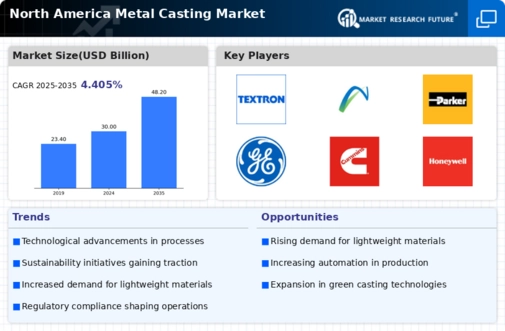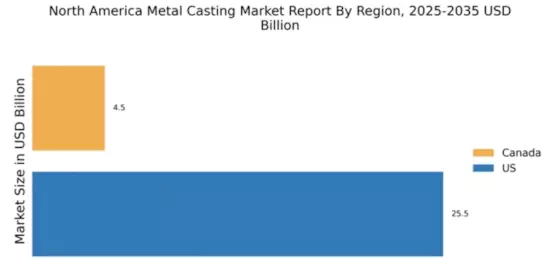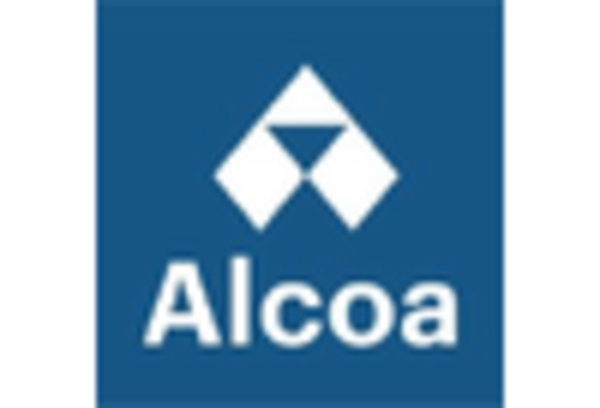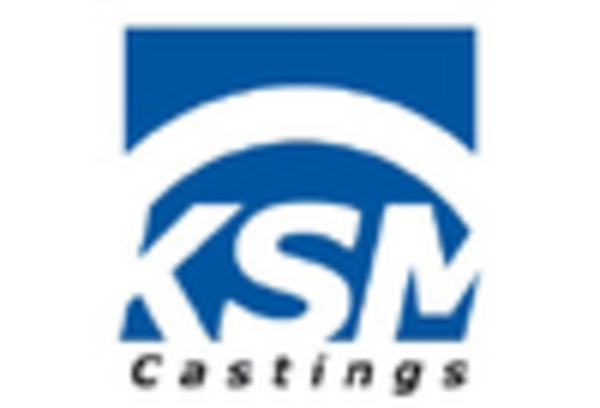Rising Demand in Automotive Sector
The automotive sector in North America is experiencing a notable surge in demand for lightweight and durable components, which is driving growth in the metal casting market. As manufacturers strive to enhance fuel efficiency and reduce emissions, the need for advanced casting techniques becomes paramount. In 2025, the automotive industry is projected to account for approximately 30% of the total metal casting market revenue in North America. This trend is further fueled by the increasing adoption of electric vehicles, which require specialized components that can be efficiently produced through metal casting processes. Consequently, the metal casting market is likely to benefit from this rising demand, as companies invest in innovative casting technologies to meet the evolving needs of the automotive sector.
Infrastructure Development Initiatives
Infrastructure development initiatives across North America are significantly impacting the metal casting market. With government investments in transportation, energy, and public works projects, the demand for metal castings is expected to rise. In 2025, infrastructure spending is projected to reach $1 trillion, creating a robust market for cast metal products used in construction and heavy machinery. This growth is driven by the need for durable and high-performance materials that can withstand the rigors of infrastructure applications. As a result, the metal casting market is poised to capitalize on these initiatives, with manufacturers focusing on producing high-quality castings that meet stringent regulatory standards.
Growth in Aerospace and Defense Sectors
The aerospace and defense sectors are emerging as critical drivers for the metal casting market in North America. With increasing investments in military modernization and commercial aviation, the demand for high-performance metal components is on the rise. In 2025, the aerospace sector is expected to contribute approximately 25% to the overall metal casting market revenue. This growth is attributed to the need for lightweight and durable materials that can withstand extreme conditions. Consequently, manufacturers are focusing on developing specialized casting techniques to meet the stringent requirements of these sectors. The metal casting market is thus positioned to benefit from this upward trend, as companies align their production capabilities with the needs of aerospace and defense applications.
Technological Innovations in Casting Processes
Technological innovations in casting processes are reshaping the landscape of the metal casting market in North America. Advancements such as 3D printing and computer-aided design (CAD) are enabling manufacturers to produce complex geometries with greater precision and efficiency. In 2025, it is estimated that 20% of metal castings will be produced using advanced technologies, reflecting a shift towards more sustainable and cost-effective production methods. These innovations not only enhance product quality but also reduce waste and energy consumption, aligning with the industry's goals for sustainability. As a result, the metal casting market is likely to see increased competitiveness and profitability as companies adopt these cutting-edge technologies.
Increased Focus on Recycling and Sustainability
The increased focus on recycling and sustainability is significantly influencing the metal casting market in North America. As environmental regulations become more stringent, manufacturers are adopting practices that minimize waste and promote the use of recycled materials. In 2025, it is anticipated that recycled metal will account for over 40% of the raw materials used in the metal casting market. This shift not only reduces the environmental impact but also lowers production costs, making it an attractive option for manufacturers. The metal casting market is likely to see a rise in demand for eco-friendly casting solutions, as companies strive to enhance their sustainability profiles while meeting the growing consumer preference for environmentally responsible products.


















Leave a Comment